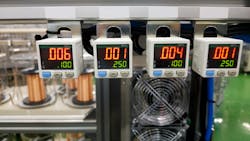BAK Food Equipment makes machines smarter with sensing data
Thomas Bako is director of business development at BAK Food Equipment, the exclusive U.S. distributor of food processing equipment from manufacturers such as Nowicki, Protech, and N&N Nadratowski.
Bako has more than 25 years of experience in manufacturing and industrial process automation. Most recently, he was sales and marketing director for a major subsidiary of a $171 million global company that designs and manufactures sensors and process control instrumentation for several key industrial market segments, including food and beverage processing machinery.
Bako holds advanced SCADA certification in InduSoft Web Studio, now Wonderware, and completed the High Performance Leadership Program at Oxford University.
Tell us about your company’s state-of-the-art sensing technology.
Thomas Bako, director of business development, BAK Food Equipment: We are a user of sensing technology. The equipment BAK Food Equipment provides to our customers includes sensors for temperature; pressure, for injectors, brine, and vacuum for tumblers; tank levels; position; and proximity. These sensing technologies obtain quality and reliable results, increase food production throughput and help meet safety requirements. In addition, companies can integrate the data collected from these technologies into our supervisory-control-and-data-acquisition (SCADA) system and use it for remote monitoring.
What have been the biggest improvements to sensing technology in the past five years?
Thomas Bako, director of business development, BAK Food Equipment: For sensors in general, the biggest improvements have been miniaturization, digitalization, lower power requirements, easier configuration, data generation and connectivity. In the meat-processing and equipment industry, sensors and automation of equipment have been key in solving challenges related to filling positions needed for seasonal work, let alone regular shifts. At BAK Food Equipment, we offer a Continuous Spiral Bacon Cooking/Chilling System, for example. Typically, bacon operations are manual and require 40-plus employees to operate. Our automated system takes two people to fully operate. This helps the producer to solve one of the biggest challenges—finding adequate staffing for current operations. Automation is also widely understood to improve a company’s overall culture and employee retention rates. Automation creates product consistency from batch to batch and improves safety by sparing workers from having to perform dangerous or repetitive tasks.
What’s the most innovative or efficient sensing-technology application you’ve ever seen or been involved with?
Thomas Bako, director of business development, BAK Food Equipment: Smart sensors, or single sensors that can perform multiple functions.
How has sensing technology benefitted from remote monitoring and connectivity?
Thomas Bako, director of business development, BAK Food Equipment: It has hugely benefitted. A smart sensor’s ability to connect and communicate allows for a wealth of data points to be available digitally, directly from the sensor, versus traditional mechanical and analog signals. Machinery and processes on the plant floor are automatically integrated into business systems, human-machine interfaces (HMIs) providing data and SCADA systems. For operators, everything gets easier and more efficient, including predictive and preventive maintenance, processes, safety and data collection and storage. All this data can then be analyzed to make decisions. A smart sensor’s ability to preprocess data is another key because it minimizes loads on networks, process controls and cloud resources. BAK Food Equipment offerings, as an option, can be equipped with a SCADA monitoring system, which provides full visibility, control, remote monitoring and recording of all parameters on our cutters, vacuum tumblers, injectors, cleaning systems, and our industry-changing Continuous Spiral Bacon Cooking/Chilling System.
Can you explain how software development has changed sensing-technology design and production?
Thomas Bako, director of business development, BAK Food Equipment: Software development has impacted the design and production of sensing technology by giving us the tools to simplify electrical and mechanical design, computations, manipulation of data, artificial intelligence (AI) to do simulations validating and proof of concept of new sensor technology and functionality.
How do sensing technologies figure into digital-twin platform models being used by manufacturers?
Thomas Bako, director of business development, BAK Food Equipment: More powerful smart sensors have made it possible to virtually replicate a physical object or environment. One of the benefits of using digital-twin modeling is the ability to make the best decisions about the product or environment being evaluated.
When will sensing technology become IT friendly enough that engineers are no longer required for installation and operation?
Thomas Bako, director of business development, BAK Food Equipment: Engineers will always be essential. Increasingly, we will see sensors with single-button configuration, perhaps wireless, self-adapting and configuration characteristics. But having engineers with the deep technical knowledge of sensing technology and the processes in which sensors are used will always remain.
What future innovations will impact the use of sensing technology in manufacturing operations?
Thomas Bako, director of business development, BAK Food Equipment: Further advances in smart sensing technologies, connectivity, prevention, prediction and access to a wealth of data points will allow manufacturers to reduce manufacturing costs, produce higher quality products, improve productivity, drive continuous advancements, create smarter product, guide operators, allow for better supply chain planning and reduce manufacturing errors.

